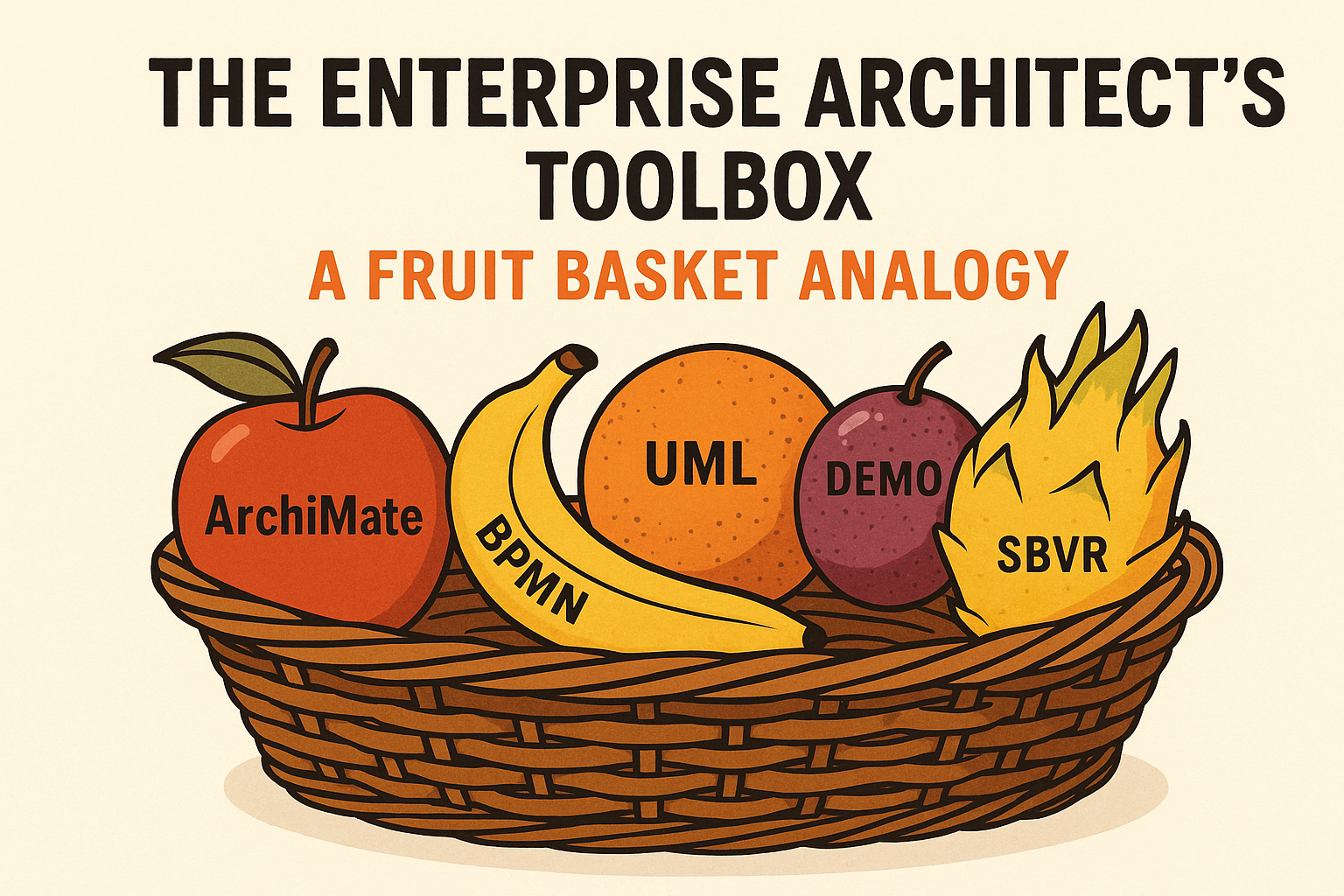In the ever-evolving world of enterprise architecture (EA), architects are constantly faced with decisions about which frameworks, modeling languages, and methods to use. Should you use ArchiMate or BPMN? UML or DEMO? TOGAF or something leaner? The options can be overwhelming. But here’s a fun and surprisingly useful analogy to help make sense of it all: think of your enterprise architecture toolbox as a fruit basket.

Just like fruits, architectural tools come in different shapes, sizes, colors, and flavors. Each has its strengths and weaknesses, and not every fruit is right for every dish. Likewise, not every modeling language or method is right for every organizational challenge. Sometimes you need the crispness of an apple, and other times, the zing of a passion fruit.
Whether you’re building digital twins, aligning business and IT, or slicing through technical debt, your job as an architect is less about being a tool purist and more about being a skilled fruit sommelier. Let’s dig into the basket.
The Fruit Basket Analogy
ArchiMate®: The Apple
Let’s start with the classic: ArchiMate. This is your apple: universally recognized, reliable, and works in a variety of recipes. As ArchiMate helps describe and relate business, application, and technology layers in a coherent way, it is often the first modeling language that comes to mind when talking about EA.
But even apples can be overused. If all you have is ArchiMate, every problem starts looking like an enterprise core diagram.
BPMN™: The Banana
Business Process Model and Notation (BPMN) is our banana: bright, approachable, and easy to peel open for business users. It’s great when you need to describe how work gets done, especially across departments or systems.
BPMN is highly digestible – until you hit complex event gateways, and then things can get slippery. Still, for modeling operations, workflows, and service interactions, BPMN is a go-to snack that rarely goes out of season. But beware: try to cook everything with bananas, and you might end up with a mushy mess.
UML®: The Orange
Unified Modeling Language (UML) is the orange: structured, multi-segmented, and a bit more effort to enjoy. Loved by software engineers, UML includes class diagrams, use cases, sequence diagrams, and more. It gives you precision and structure – at least, when you can handle the juice.
But watch out: get too deep into modeling every relationship and interaction, and you might peel back more than you bargained for. Still, UML’s flavor is hard to beat when you’re modeling software logic and system behaviors. Just make sure you don’t try to explain a sequence diagram to a CFO unless you want to see someone go sour.
DEMO: The Passion Fruit
Now for something a little more exotic: DEMO (Design & Engineering Methodology for Organizations) is the passion fruit of the basket; small, tangy, and packed with surprising intensity. It is grounded in solid theoretical roots like the systems theory and communicative action theory. Where others focus on the structure of systems or processes, DEMO reveals the essence of organizations in terms of the commitments between actors. It’s precise yet high-level, and offers insights that no other methods can provide.
Just like passion fruit, DEMO might not be in every supermarket (or EA team), but when you need to cut through organizational spaghetti and expose its core essence, it delivers a burst of clarity that no other fruit ever could.
TOGAF®: The Watermelon
TOGAF? Definitely a watermelon. Massive, full of content, and best consumed in slices. Don’t try to carry the whole thing around at once – it’ll wear you out. But portioned strategically, it’s refreshing and satisfying for large-scale enterprise transformation work. Just be sure to separate the juicy bits from the seeds of legacy bureaucracy.
Other Fruits in the Basket
- Zachman Framework™: The pomegranate; classic, highly structured, and filled with a seemingly endless number of seeds (perspectives and abstractions). Beautiful, but extracting useful parts takes patience and technique. Bonus: no two people seem to agree on how best to eat it.
- IAF (Integrated Architecture Framework): The grapefruit; large, slightly bitter, and best when consumed with a spoon. Offers a broad but structured take on enterprise architecture, often used by big consultancies. Not everyone’s favorite breakfast fruit, but when you need it, it does the job.
- C4 Model: The blueberry; tiny, sweet, and powerful in the right context. Ideal for modern software architecture views, especially in microservices or agile environments. A good handful often does the job.
- ORM (Object-Role Modeling): The fig; ancient, philosophical, and full of depth. ORM focuses on semantics and fact-based modeling. Great for conceptual modeling where precision and constraints matter. A bit of an acquired taste, but surprisingly versatile once you get it.
- SysML®: The kiwi; fuzzy, somewhat niche, and full of dense, engineering-grade nutrition. Popular with systems engineers and those designing cyber-physical systems. A bit complex to peel, but worth the effort.
- SBVR™ (Semantics of Business Vocabulary and Business Rules): The dragon fruit; fascinating, slightly alien-looking, but bursting with structured meaning. SBVR is all about defining clear business vocabulary and logic in natural language. Exotic and misunderstood, but beautiful when used properly – and surprisingly healthy for your business rules.
- BIZBOK®: The coconut; hard to crack, but full of richness once opened. The Business Architecture Body of Knowledge can be dense, but also nourishing for strategy-driven modeling.
- DYA (Dynamic Architecture): The lime; small, sharp, and focused on agility. Developed in the Netherlands, DYA brings tangy freshness to architectural governance, emphasizing just-enough architecture and the dynamics of change. Ideal when you need to zest up your project portfolio.
- SAFe®: The pre-made fruit salad; packaged, structured, and full of pre-chopped components. Convenient for large enterprises trying to scale agile, but may include unexpected pineapple chunks.
Situational, Seasonal and Sensible
Enterprise architects, like good chefs, need to choose their fruits wisely. Not every modeling approach is suitable for every context. Some tools are general-purpose; others are specialty ingredients. Just because you can use UML for everything doesn’t mean you should—just as you wouldn’t try to make a fruit tart with only oranges and coconut. Here are a few parting thoughts:

- Context is king: Consider the organizational setting, stakeholder expectations, and project goals before choosing your modeling approach. Your fruit needs to match the dish.
- Don’t marry your fruits: It’s tempting to stick with what you know, but innovation often comes from combining familiar flavors with something new. Just be cautious with your fruit pairings; not every pear makes a good pair! Mixing BPMN and UML? That’s like putting bananas in orange juice – it might work, but only if you blend carefully.
- Keep your basket varied: Mastering multiple modeling methods allows you to stay flexible and effective. A good architect doesn’t just reach for apples every time.
- Know your seasons: Some tools are perfect for greenfield initiatives; others shine in legacy modernization. Learn which are ripe for which season.
- Stay curious: Try that starfruit once in a while. You might discover a new favorite.
The Fruit Whisperer of Enterprise Architecture

Enterprise architecture is ultimately about making sense of complexity, enabling change, and telling clear stories across business and technology. Whether you’re slicing diagrams, mixing methods, or seeding transformation strategies, your fruit basket is your friend.
So next time someone asks why you’re using DEMO, smile and say, “Because sometimes, only passion fruit will do.”
Notes
- This article was written with the help of AI.
- ArchiMate and TOGAF are registered trademarks of The Open Group.
- BPMN and SBVR are trademarks of the Object Management Group, Inc. UML and SysML are registered trademarks of the Object Management Group, Inc.
- The Zachman Framework for Enterprise Architecture is a trademark of Zachman International, Inc.
- BIZBOK is a registered trademark of the Business Architecture Guild®.
- SAFe is a registered trademark of Scaled Agile, Inc.

Comments (0)